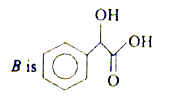An aromatic compound T (C10H10O2) gives 2 moles of CHI2 and compound U (C8H4O4Na) on treatment with I2.and NaOH . After acidification U gives two mononitro products on nitration.
Compound U is




The correct Answer is:B
To solve the problem, we need to determine the structure of compound U (C8H4O4Na) based on the information provided. Here’s a step-by-step breakdown of the solution:
Step 1: Analyze the given information
- We have an aromatic compound T with the formula C10H10O2.
- Upon treatment with I2 and NaOH, compound T yields 2 moles of CHI2 and compound U (C8H4O4Na).
- After acidification, compound U can undergo nitration to give two mononitro products.
Step 2: Determine the structure of compound T
- The molecular formula C10H10O2 suggests that compound T is likely a substituted aromatic compound.
- The presence of 2 moles of CHI2 indicates that there are two methyl groups adjacent to a carbonyl group (as the reaction involves the formation of iodoform).
Step 3: Identify the structure of compound U
- After the reaction, compound U has the formula C8H4O4Na. This suggests that U is a sodium salt of a dicarboxylic acid.
- The presence of two carboxylate groups (from the formula) indicates that U could be a derivative of phthalic acid.
Step 4: Consider the nitration of compound U
- The fact that U gives two mononitro products upon nitration suggests that U has two positions available for substitution on the aromatic ring.
- This is consistent with the structure of sodium phthalate (the sodium salt of phthalic acid), which has two available positions for nitration.
Step 5: Conclude the structure of compound U
- Based on the above analysis, compound U is likely sodium phthalate (C8H4O4Na).
Final Answer
Compound U is sodium phthalate (C8H4O4Na).
---
- We have an aromatic compound T with the formula C10H10O2.
- Upon treatment with I2 and NaOH, compound T yields 2 moles of CHI2 and compound U (C8H4O4Na).
- After acidification, compound U can undergo nitration to give two mononitro products.
- The molecular formula C10H10O2 suggests that compound T is likely a substituted aromatic compound.
- The presence of 2 moles of CHI2 indicates that there are two methyl groups adjacent to a carbonyl group (as the reaction involves the formation of iodoform).
- After the reaction, compound U has the formula C8H4O4Na. This suggests that U is a sodium salt of a dicarboxylic acid.
- The presence of two carboxylate groups (from the formula) indicates that U could be a derivative of phthalic acid.
- The fact that U gives two mononitro products upon nitration suggests that U has two positions available for substitution on the aromatic ring.
- This is consistent with the structure of sodium phthalate (the sodium salt of phthalic acid), which has two available positions for nitration.
- Based on the above analysis, compound U is likely sodium phthalate (C8H4O4Na).
Compound U is sodium phthalate (C8H4O4Na).
Topper's Solved these Questions
Similar Questions
The compound which gives H2O2 on treatment with dilute acid is
View SolutionAn aromatic compound (A), C7,H6Cl2 gives AgCl on boiling with alcoholic AgNO3 soln. And yields C7H7Ocl on treatment with NaOH. (A) on oxidation gives a monochlorobenzoic acid which affords only the monoderivative on nitration the compound (A) is
View Solution
Knowledge Check
Compound (A) C8H6O2 on treatment with aq. NaOH followed by acidification gives (B) C3H2O3 which on oxidation gives benzoic acid only:
A B
B C
C D
D
A hydrocation (A)(C8H10)(E) is a stream volatile compound and on nitration gives two mononitro derivatives. (A) gives the following reactions.

Compound (C) is:
View SolutionA hydrocation (A)(C8H10)(E) is a stream volatile compound and on nitration gives two mononitro derivatives. (A) gives the following reactions.

Compound (A) is:
View SolutionA hydrocation (A)(C8H10)(E) is a stream volatile compound and on nitration gives two mononitro derivatives. (A) gives the following reactions.

Compound (D) is:
View SolutionA hydrocation (A)(C8H10)(E) is a stream volatile compound and on nitration gives two mononitro derivatives. (A) gives the following reactions.

Compound (E) is:
View SolutionA hydrocation (A)(C8H10)(E) is a stream volatile compound and on nitration gives two mononitro derivatives. (A) gives the following reactions.

Compound (B) is:
View SolutionAn aromatic compound 'X' (C9H8O3) turns blue litmus to red.It gives yellow precipitate with I2/NaOH and forms Y (C8H5O4). Y forms three mononitro isomeric products. Identify X.
View SolutionAn organic compound X(C4H8O2) gives positive test with NaOH and Phenopthalein. Structure of X will be:
View Solution

